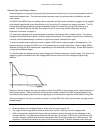
Tsunami MP.11 Antenna Installation
Copyright © 2006 Proxim Wireless Corporation. All rights reserved. 20
Antenna Alignment Display Feature
Antenna alignment is a process to physically align the antennas of both units to have the best possible radio link
established between them. The antenna alignment process usually is performed during installation and after
major repairs.
The 2454-R and 5054-R have an audible antenna alignment tool that can be activated by plugging in the supplied
serial dongle (supplied with every Base Station) or by issuing the CLI command for antenna alignment. The CLI
command causes both audible and numerical feedback as the CLI shows the running SNR values twice a
second. The model 5054 has the SNR value output on the CLI but not the audible output (see “Antenna
Alignment Commands” on page 21).
The output from the beeper for antenna alignment consists of short beeps with a variable interval. The interval
changes with the SNR level to assist in correctly aligning the antenna. An increase in signal level is indicated by
a shorter interval between beeps; a reduction in signal level results in beeps further apart.
To allow for precise antenna alignment, small changes in SNR result in large changes in the beep period. The
alignment process averages the SNR, which is represented by an average length beep. When a higher SNR is
received, the beep period is made shorter, dependent upon the difference to the average. A lower SNR results in
a longer period between beeps.
The first five steps are represented by a large change and all following steps are a small change. This acts as if a
magnifying glass is centered around the average SNR and the values next to the average are significantly
different.
When the antenna is aimed, the beep can easily be heard if the SNR is rising (shorter period, higher frequency) or
falling (longer period). When the position of the antenna has been changed, the SNR averaging settles at the
new value and the beeping returns to the average length so the antenna can again be aimed towards rising SNR.
Aiming is complete if moving in any direction results in a falling SNR value, which can be heard as longer periods
between beeps.
Notes:
• Antenna alignment for the Base Station is useful only for a point-to-point link.
• The range of the average SNR is limited to values from 0 to 48. Anything over 48 is capped at 48.
• AAD is automatically disabled 30 minutes after it is enabled to remove the load of extra messages on the
wireless interface. The default telnet timeout is 900 seconds (15 minutes). If AAD must run for the entire 30
minutes, change the default telnet timeout value greater than 30 minutes (greater than 1800 seconds). This
restriction is for telnet connections only and not for the serial interface. The serial interface never times out.


















